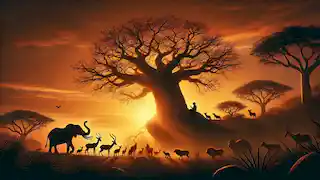The sun hung low in the sky over the savannah, casting long shadows over the grasslands as the golden light bathed the ancient Baobab tree in an ethereal glow. The tree stood tall and solitary, its gnarled branches reaching toward the heavens, each one telling a story of resilience, wisdom, and survival. It had watched over the land for centuries, witnessing the rise and fall of civilizations, the migration of animals, and the slow passage of time.
This was no ordinary tree. Known to the local tribes as "The Tree of Life," the Baobab was as much a part of the landscape as the earth beneath it, and its roots were woven deeply into the fabric of history and legend. Its massive trunk, large enough to hollow out and live in, held stories that spanned generations. Many believed that the spirits of ancestors resided within the tree, watching over their descendants and offering protection to those who sought its shelter.
To begin the tale of the Baobab Tree is to journey back to a time before history was written, when the world was young, and the land was wild. It is a story of how this magnificent tree came to be, of the gods who blessed it, the people who revered it, and the mysteries that surround its ancient origins.
The Birth of the Baobab
Long ago, when the earth was new and the gods still roamed freely among men, there was no Baobab tree. In fact, the world was a vastly different place—untamed and raw, filled with creatures of immense size and power. The gods had molded the land with their hands, shaping mountains, rivers, and forests, and breathing life into all that would walk, crawl, and fly.
Among these gods was a deity known as Akila, the goddess of earth and growth. She was responsible for all that bloomed and bore fruit, and it was said that her footsteps brought forth fields of flowers and trees. She loved the world dearly and delighted in watching her creations thrive under the warmth of the sun. But despite her efforts, Akila felt that something was missing from the landscape, something that would stand as a testament to both time and nature, something grand and majestic that would remain eternal.
One day, as Akila wandered the savannah, she gazed out over the dry and barren plains. The land stretched out endlessly before her, devoid of shade or sanctuary for the animals and people who roamed the region. A deep sadness settled in her heart as she realized how inhospitable this part of the world had become. The sun beat down relentlessly, and there was no refuge from its scorching rays.
It was then that Akila decided to create the Baobab tree. She would plant it in the center of the savannah, where it would grow and provide shelter, shade, and nourishment for all living things. But this tree would be unlike any other—it would be enormous, with roots that stretched deep into the earth to draw water from the driest of places. Its trunk would be wide and strong, able to store water for years and sustain itself even during the harshest droughts. And its fruit, though odd-looking, would be rich in nutrients, providing sustenance to those in need.
Akila knelt on the ground, placed her hands into the soil, and began to sing. Her voice was soft at first, a gentle hum that carried on the wind, but as she continued, the earth trembled beneath her feet. The soil shifted, and from the ground, a tiny sapling emerged. Akila smiled and continued her song, watching as the sapling grew taller and stronger with each passing moment. Its roots dug deep into the earth, seeking water from the underground streams, while its trunk thickened and expanded, reaching toward the sky.
The Baobab tree grew quickly, towering over the landscape within days, its massive branches spreading wide to cast shade over the savannah. Animals began to gather beneath it, seeking refuge from the sun, and people soon followed, drawn by the tree's promise of sustenance and shelter. The Baobab had become a beacon of life in an otherwise desolate land, and Akila was pleased with her creation.
The Curse of the Baobab
As the Baobab tree grew, so too did its reputation. People came from far and wide to see the magnificent tree, and soon it became the center of life in the savannah. The tribes who lived nearby revered the Baobab, believing it to be a gift from the gods, and they often left offerings of food and water at its base in thanks for its bounty.
But not all were pleased with the Baobab's presence. Among the gods, there was one who grew jealous of Akila's creation. His name was Rongo, the god of the skies and storms, and he had long been envious of Akila's power over the earth. He watched with resentment as the Baobab flourished, drawing praise and adoration from the people.
Rongo was a tempestuous god, known for his quick temper and fierce jealousy. He had tried many times to outshine Akila, creating fierce storms and floods in an attempt to prove his superiority, but none of his efforts had earned him the reverence that the Baobab tree had brought to Akila.
One day, as Rongo looked down from his cloud-filled domain, he decided that he would curse the Baobab tree. He would teach Akila a lesson and show her that her creations were not immune to the power of the skies. With a thunderous roar, Rongo descended from the heavens and approached the tree, his eyes blazing with fury.
"You think you're so mighty, don't you?" Rongo hissed as he stood before the Baobab. "You think you are eternal, but I shall show you the power of the sky."
And with that, Rongo raised his hands and unleashed a torrent of wind and rain upon the tree. The Baobab swayed and groaned under the force of the storm, but its roots held fast to the earth. Rongo's rage only grew as he saw the tree withstand his assault, and he summoned more storms, more winds, more lightning.
For days, Rongo battered the Baobab, but no matter how fierce the storms became, the tree refused to fall. Its roots were too deep, its trunk too strong. Finally, exhausted and defeated, Rongo withdrew, leaving the Baobab standing tall, though forever marked by his curse. From that day forward, the Baobab's branches no longer reached toward the sky as they once had. Instead, they twisted and turned downward, as if the tree had been uprooted and planted upside down.
The people noticed the change, but they did not stop worshiping the Baobab. If anything, the tree's resilience in the face of Rongo's fury only strengthened their belief in its divine nature. They began to tell stories of how the Baobab had once tried to grow into the heavens, but the jealous god of the sky had cursed it to grow upside down. The Baobab became a symbol of endurance and strength, a reminder that even in the face of adversity, life would go on.

The Guardians of the Baobab
As the centuries passed, the Baobab tree continued to thrive, standing as a silent witness to the changes that swept across the savannah. Tribes came and went, animals migrated, and civilizations rose and fell, but the Baobab remained. It had become more than just a tree—it was a guardian of the land, a protector of the people who lived in its shadow.
Many legends grew around the Baobab, and one of the most enduring was the tale of the Guardians. It was said that every generation, a group of chosen individuals would be born under the Baobab's watchful branches, destined to protect the tree and ensure its survival. These Guardians were not just warriors; they were healers, scholars, and spiritual leaders, each one connected to the Baobab in a way that transcended the physical world.
The story of the first Guardians began in a time of great turmoil. A drought had gripped the land, and the people were suffering. The rivers had dried up, the crops had withered, and the animals had begun to migrate in search of water. The Baobab, however, continued to stand tall, its trunk full of stored water, offering life to those who sought its shade.
One night, as the people gathered beneath the Baobab to pray for rain, a strange figure appeared. She was old and frail, her hair white as snow, and her eyes shone with an otherworldly light. The people gasped in awe as she approached the tree, her hands outstretched as if in communion with it.
"I am Asali," the woman said, her voice soft but commanding. "I have been sent by the spirits of the ancestors to guide you in this time of need."
The people listened in silence as Asali spoke. She told them that the Baobab was more than just a tree—it was a bridge between the world of the living and the world of the spirits. The ancestors, she said, had chosen the Baobab as their dwelling place, and they watched over the people from within its branches. But now, the spirits were troubled, for the balance between the earth and the sky had been disturbed.
"As the Guardians of the Baobab, it is your duty to protect this sacred tree and restore balance to the land," Asali declared. "But the path ahead will not be easy. You must prove yourselves worthy, for the spirits do not give their blessings lightly."
The people looked at one another, unsure of what to do. They had always revered the Baobab, but the idea of becoming its Guardians was daunting. But Asali did not waver. She pointed to a group of young men and women who had been born beneath the tree, marking them as the chosen ones.
"You are the first of the Guardians," she said. "It is your destiny to protect the Baobab and ensure that its power is never misused."

Trials of the Guardians
The first Guardians, though young, took their new roles seriously. They trained under Asali's guidance, learning the ways of the Baobab and the spirits who resided within it. They practiced rituals to honor the tree, studied the ancient texts that spoke of its origins, and trained their bodies to be strong and resilient.
But becoming a Guardian was not just about physical strength—it required a deep connection to the Baobab itself. The tree was alive in ways that the people could not fully understand, and the Guardians needed to attune themselves to its rhythms, to feel the pulse of the earth beneath their feet and the breath of the wind through its branches.
One by one, the Guardians faced their trials. Some were tasked with surviving in the harsh wilderness, using only the resources that the Baobab provided. Others were sent on journeys to distant lands, seeking knowledge and wisdom that could help protect the tree. And some were tested in ways that defied explanation, facing visions and dreams that revealed the deeper mysteries of the Baobab.
One of the most famous trials was that of a young Guardian named Nia. She had always felt a special connection to the Baobab, even as a child, and it was said that she could hear the whispers of the spirits within its bark. But Nia's trial was not one of strength or endurance—it was a test of faith.
One night, as she meditated beneath the Baobab, Nia had a vision. In her dream, she saw the tree engulfed in flames, its branches crackling and turning to ash as a great darkness spread across the land. The people fled in terror, and the animals scattered, leaving the savannah barren and desolate.
When Nia awoke, she was shaken to her core. She knew that the vision was a warning, but she did not know how to prevent the disaster that she had seen. She went to Asali, seeking guidance, but the old woman only smiled.
"The Baobab speaks to you, Nia," Asali said. "It shows you what may come, but it does not dictate what must be. You are the Guardian, and it is your choices that will shape the future."
With these words in mind, Nia set out on a journey to discover the meaning of her vision. She traveled across the savannah, seeking the wisdom of the elders and the knowledge of the ancient texts. Along the way, she encountered many challenges—drought, famine, and even hostile tribes who sought to claim the Baobab's power for themselves.
But Nia remained steadfast, trusting in the guidance of the Baobab and the spirits who dwelled within it. In the end, she returned to the tree, having learned the true meaning of her vision. The flames she had seen were not a literal fire, but a metaphor for the greed and destruction that would come if the people did not honor the balance between the earth and the sky.
Nia shared her knowledge with the other Guardians, and together they worked to protect the Baobab and restore harmony to the land. They built altars to honor the spirits, performed rituals to ensure the flow of water and rain, and taught the people to live in harmony with the earth.
Under the Guardians' watchful eyes, the Baobab continued to thrive, and the land flourished. The drought ended, the rivers flowed once more, and the animals returned to the savannah. The people celebrated, knowing that the Baobab's power had been preserved for future generations.
The Eternal Tree
Centuries passed, and the story of the Baobab tree became legend. The Guardians continued to protect the tree, passing down their knowledge and traditions from one generation to the next. The Baobab remained a symbol of life, endurance, and the deep connection between the earth and the sky.
But the world around the Baobab began to change. The savannah, once wild and untamed, was now dotted with villages and farms. The people who had once relied on the Baobab for sustenance now had access to modern conveniences, and the tree's role in their lives began to diminish.
Still, the Baobab stood tall, a silent witness to the passage of time. Its branches, twisted and gnarled, reached toward the earth, a reminder of the curse that had once been placed upon it. But the tree did not falter. It had survived storms, droughts, and even the wrath of the gods, and it would continue to stand as long as the earth itself endured.

The Legacy of the Baobab
In the end, the Baobab tree's true power was not in its size or its age, but in the stories that it inspired. The people who lived beneath its branches may have changed, but the legends of the Baobab remained. They told of the goddess Akila, who had planted the tree to bring life to the savannah, and of the god Rongo, whose jealousy had cursed it. They spoke of the Guardians, who had dedicated their lives to protecting the tree and ensuring that its power was never misused.
And so, the Baobab continued to stand, its roots deep in the earth, its branches reaching toward the sky. It was a symbol of resilience, of the enduring connection between nature and humanity, and of the power of stories to shape the world.
In time, the people would forget the details of the Baobab's history. They would forget the names of the gods and the Guardians, and the rituals that had once been performed in its honor. But the tree itself would remain, a silent reminder of the ancient bonds that connected all living things.
As the sun set over the savannah, casting long shadows across the land, the Baobab tree stood tall, its branches swaying gently in the evening breeze. And though the world around it continued to change, the Baobab would endure, as it always had, for it was the Tree of Life, and its story was far from over.


















